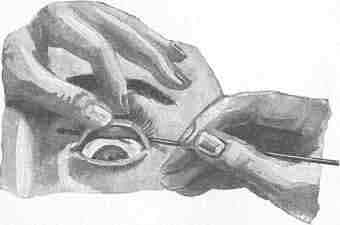Strengthening the Eyes
by Bernarr A. MacFadden, Strengthening the Eyes; A System of Scientific Eye Training.
CHAPTER XIII
Injuries to the Eye
THE eye is one of the most delicate portions of the human body; and although Nature has endeavored to protect it from injury by embedding it deep within the skull, surrounding it, so far as possible, with a circular orbit of bone, and veiling it with lids that close at the slightest hint of danger, it can not always escape injury. This chapter will treat of the most common of the accidents to which it is liable, and of the speediest and most efficient measures that can be adopted in such cases.
Foreign Bodies in the Eye. Probably the most common form of injury from which the eyes suffer is that resulting from the intrusion into it of small particles of dust, cinders, etc. These cause extreme discomfort, if not actual pain, accompanied by a flow of tears. This watering of the eye is really an effort on the part of nature to expel the offending substance, the water tending to wash the particle from the eyeball, and into the lachrymal canals, which carry it into the nose. If the particle lodges in the corner of the eye, it can be removed by means of the corner of a handkerchief, or a point twisted into it. Most foreign substances can readily be removed in this manner—provided the eye be not rubbed. If you rub the eye, it tends to embed the grit, or whatever it may be, more deeply in the eyeball, and if the substance has sharp points, it is liable to become so deeply embedded that it becomes difficult to remove. If, when a foreign body finds its way into the eye, the temptation to do this be resisted, the substance can readily be removed in practically every case.
Smooth bodies rarely cause much trouble, but bodies having rough cutting edges may often lodge in the conjunctiva and cause intense pain. The right method of extraction is to evert the eyelid, when it will be found easy in the majority of cases to remove the cinder, or whatever it may be, by means of a small, clean, soft paint brush or the corner of a handkerchief. Direct the patient to look downwards, if the body has lodged on the upper eyelid, then turn the eyelid back over a toothpick, match or pencil. If the body is seen to be near the edge of the upper lid, it can often be removed by lifting the lid up by means of the eyelashes, and bringing it over the lashes of the lower lid. These then act as a sort of broom, and sweep out the foreign body. As in all such cases, the free flow of tears is helpful.
When a foreign body has lodged in the firmer tissue of the cornea, its extraction is not so simple a matter, and rubbing only presses it in more firmly. In such cases, the particle is often driven in with considerable force, and it is usually so small that a magnifying glass must be employed to see it clearly. If the body be of iron or steel, it may be extracted by means of a magnet made for that purpose, otherwise a surgeon had best be sent for at once, as lasting injury may result if the substance be left in the eye too long, or if the eye be perforated, and the interior liquids allowed to escape.
Wounds made with pointed instruments, such as a knife, scissors, pin, etc., sometimes injure the cornea and lens, and the after-effect is frequently a cataract, when the eye is not totally lost. These, the formation of connective tissue, are usually absorbed in young people, but in older persons they may require an operation for their removal.
Lime may be splashed in the eye, and this is a dangerous form of injury. Quicklime is a powerful caustic, and often causes complete blindness by destroying the cornea. When this substance gets into the eye, it should be washed out as quickly as possible with water, and then with a solution of weak acid and water—say, a teaspoonful of vinegar to a glass of water. An equally efficient and more soothing method, however, is to bathe the injured eye in sweet oil.
In case of injury by acids, one part of lime-water to three of water may be used, or the eye may be freely bathed in milk. These alkalis neutralize the acid, and make it harmless or less harmful.
Sympathetic Inflammation. When one eye is injured by the entrance of some foreign body, or by a wound, the injury does not always limit itself to that eye. The other eye is also affected, and becomes inflamed through sympathy. This is noticeable even in slight injuries;but in grave cases it may become so serious as to necessitate the removal of the injured eye (that is, if the injured eye is so badly hurt as to render it blind and useless). In our days, this operation is not so serious as it used to be.

Showing the method of everting the upper eyelid for examination or removal of cinders or other foreign bodies.
| Eyes carePhysicianBate's booksTechnologyForumLaser corre.Blues under eyesburning in the eyesanother diseasesMedical mistery Naturally eyesight correction. No laser eye surgery. Restore eyesight. Vision correction. |




